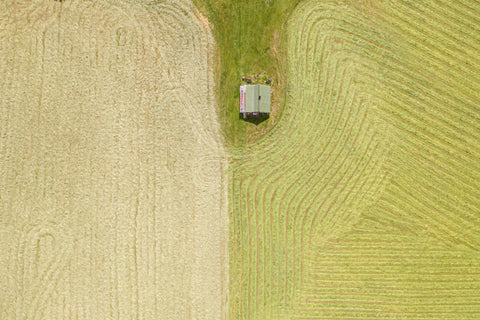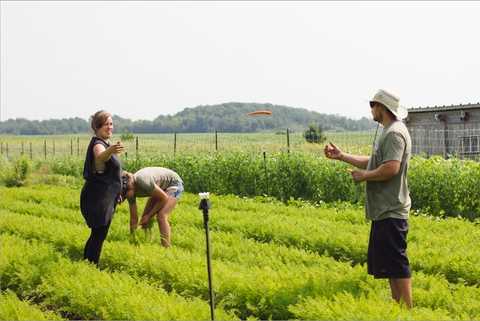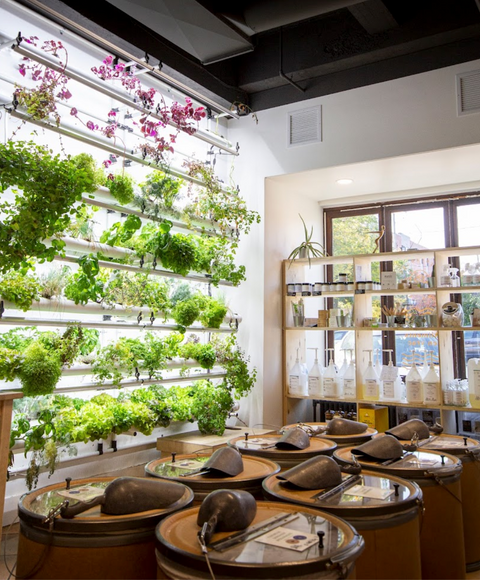What is regenerative agriculture
Regenerative agriculture brings together several agricultural practices that focus on naturally enhancing soil health and quality rather than yield. These practices are mainly based on natural farming traditions, but also on modern research and innovations in sustainable agriculture.
This method of agriculture encourages living off the land instead of killing other lives for the benefit of just one: that of humans.
The main practices
Regenerative agriculture uses four main practices.
Minimum mechanical intervention
Firstly, it uses a minimum of mechanical intervention. The goal is to imitate nature. Farmers therefore do not plow the soil and do not use chemical inputs such as pesticides or chemical fertilizers. Untilled soil can “store” more water, which increases the growth of microorganisms in the soil and therefore increases plant growth. In conventional agriculture, the more the soil is plowed, the weaker it becomes and the more chemicals farmers resort to. This creates a vicious cycle that only continually destroys the soil.
The diversity
Second, regenerative agriculture promotes diversity . By diversifying the foods that grow in the soil, it is possible to nourish the soil much more quickly, because it is made up of several types of roots. Diversity creates a more resilient ecosystem. In addition to improving soil quality, food diversity allows farmers to avoid losing all of their crops when a problem arises. For example, if the price of growing corn increases significantly one year, a farmer who grows a wide variety of vegetables will not be impacted as much as a farmer who grows only corn. The impact is limited because corn is only a small part of his entire business.
Soil protection
Third, this type of agriculture promotes soil protection and root conservation. The methods used in regenerative agriculture allow the soil to retain all microorganisms. Microorganisms are what keep the earth alive. Healthy soil allows plants to be healthy, which allows animals that eat those plants to be healthy as well. As humans, we therefore consume healthy meat, which is beneficial to our diet.
The integration of animals
Lately, livestock has played a key role in this type of agriculture.
The integration of animals is indeed very important. Animals accelerate the process of soil regeneration, thanks to the pasture farming system. Pasture farming is a process where livestock graze on grass and trample a specific area of land for a few days before being moved to another hectare of land. This hectare will not be reused for several months, thus allowing complete recovery of the soil. This grazing principle allows the land to trap carbon and continually regenerate.
In contrast, in conventional agriculture, the majority of plowed fields grow one thing: animal food. Conventionally raised animals almost always eat the same thing: soybeans, corn and hay and are concentrated in feedlots. These parks produce a huge amount of greenhouse gases. They are both harmful to the environment and to animals.
While the conventional method destroys the planet and emits a large amount of greenhouse gases, the regenerative method allows the absorption of carbon into the soil and helps heal our planet. Farmed animals in harmony with the environment and agriculture are not problematic, rather it is what humans do with them that causes significant damage to our planet.
Carbon and regenerative agriculture
After understanding the principles used, we must understand the benefits that this type of agriculture brings to our environment. The concept of regenerative agriculture is closely linked to the concept of living soil, since the microorganisms present in the soil contribute to the underground carbon cycle. Thanks to micro-organisms, soil has the ability to trap carbon dioxide out of the atmosphere. According to some scientists, adopting regenerative agricultural practices across degraded lands around the world could reduce atmospheric carbon concentrations to pre-industrial levels. Indeed, did you know that for 1% increase in organic matter, half a hectare of land absorbs ten tonnes of additional carbon? This means that the more microorganisms the soil contains, the more carbon the land absorbs.
Currently, soils cultivated using the chemical methods of conventional agriculture are almost entirely devoid of micro-organisms and therefore of life. When soil is destroyed, it releases water and carbon dioxide. This dries out the soil which turns into dust. This is a phenomenon called desertification.
Regenerative agriculture: The ideal solution
Around 25% of the planet's soil has been degraded by humans. Regenerative agriculture is not just a solution that reduces carbon dioxide. It is a solution that heals our soils and our climate that we have been continually destroying for several years. It is sustainable agriculture, agriculture that not only feeds the planet, but also humans in a way that regenerates resources and does not deplete them.
The more regenerative foods we consume, the more farmers will produce. It is therefore by changing our habits that we can help regenerative agriculture to expand. We have the power to change things now to leave future generations with a healthy planet. Let's be proud of what we produce and restore the planet one plate at a time!
Sources used for writing this article:
COG. Regenerative agriculture. Growing Organic Canada. https://www.cog.ca/en/regenerative-farming/ .
Fortier-Morissette, C. (November 20, 2017). The ABCs of regenerative agriculture. The Land of Our Home. https://www.laterre.ca/du-secteur/formation/labc-de-lagriculture-regeneatrice .
Cameron, D. (March 28, 2021). Nature is on the farm. LaPresse. https://www.lapresse.ca/actualites/2021-03-28/agriculture-regeneratrice/la-nature-est-dans-la-ferme.php .
Tickell, J & Harrell Tickell, R. (Directors) (2020). Kiss The Ground: Regenerative Agriculture. 1h24 min.






Comments (0)
There are no comments for this article. Be the first to leave a message !